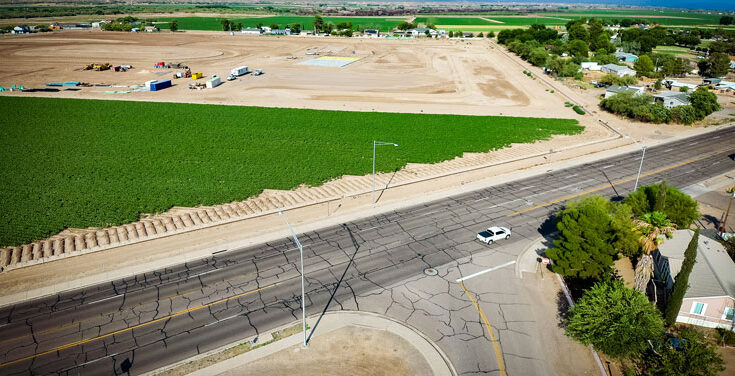Jon Johnson File Photo/Gila Herald: The town of Pima is seeking alternative funding sources after the $1 million grant for a new roadway and light for its new school was rescinded.
Graham County and Duncan look toward reapplying next year
By Jon Johnson
WASHINGTON D.C. – The federal government gives, and the federal government takes away.
The town of Pima knows this all too well. It still has $2 million from the federal government sitting in an account earmarked for use in its new fire station, but a $1 million award that was to be used toward the construction of a new road and traffic light for the new Pima High School has been rescinded.
The Pima School District is building a new high school on a 44-acre site located just north of the intersection with Highway 70 and 200 South on the east side of town. The current access is from E. Center Street, which connects to Highway 70 just west of the Dollar General store and to the east at 600 East. The new school will be just the second high school built in Pima’s 145-year history.

The campus is built to handle 500 students in classroom space, and Pima currently has about 350 students. Pima Schools Superintendent Sean Rickert advised that the number would rise when the new high school is opened. The new high school is currently under construction, with a tentative completion date in June and an opening to all students for the Fall 2025 school year the first week of August.
To help facilitate the new road and traffic light, U.S. Rep. Juan Ciscomani previously pushed through $1 million in funds through the House’s Transportation, Housing, and Urban Development package for the project. The package also approved $1.9 million for the town of Duncan to repave more than 4,000 feet on Main Street and High Street in Duncan – which have not been properly repaired in 45 years. Ciscomani also previously preliminarily secured $1.2 million for Graham County to update its water and sewer lines. The funds would have replaced some of the county’s 40-year-old waterlines and allow the county to utilize treated wastewater from the city of Safford for non-drinking purposes.
However, all of the funding preliminary secured in the last session by Rep. Juan Ciscomani has been rescinded because it was not approved in the House of Representatives Full-Year Continuing Resolution.
On March 15, President Donald J. Trump signed the Full-Year Continuing Appropriations and Extensions Act, 2025, which was passed by the House of Representatives on March 11 and the Senate on March 14.
According to a news release from the House of Representatives, the act “keeps the government operational and continues support for Americans. A stopgap is never a first choice, but the alternative would have caused harmful disruptions to the priorities the American people voted for and mandated in Washington. Funding the federal government is a constitutional obligation, and House Republicans have acted to uphold that duty.”
While the bill includes a more than $500 million increase for WIC, it also cuts funding for non-defense programs and services by $13 billion while increasing defense spending by $6 billion compared to fiscal year 2024. It also cuts non-defensive funding by $15 billion and defense by $3 billion relative to the fiscal year 2025 levels in the Fiscal Responsibility Act agreement.

On Monday, Pima Town Manager Vernon Batty and Pima Schools Superintendent Sean Rickert met with ADOT representatives to discuss possible options for the intersection into the school, including a temporary road manned by police officers on traffic duty in the morning and afternoon.
Batty told the Gila Herald he was always looking for additional funding for the stoplight and road anyway since the $1 million wouldn’t have been enough for the entire project. He is looking at other sources, including the Safe Routes to Schools program.
“I was continuing to look for further funding, and I will continue to do that.”
Rickert issued a positive note after their meeting with ADOT on Monday and told the Gila Herald that while the intersection has been pushed back, the school is still on track to open the first week of August.
Graham County waterline project
Those who were preliminary approved funding from the U.S. House of Representatives Appropriations Committee that had that funding rescinded will be given priority to have their projects approved during the next year’s funding cycle. That is according to emails sent to those entities, including Graham County.
The county had been approved for $1.2 million to update its water and sewer lines. Graham County Manager Dustin Welker advised that the county would look to reapply for those funds and will also seek elsewhere.
“We’ve been told by the offices of Representative Ciscomani and Senators Kelly and Gallego that there may be an opportunity for funding through CDS for FY26,” Welker wrote the Gila Herald in an email. “We will seek after that opportunity and any other grant opportunities we can identify or possibly through county funds as we go through the budget process in the next few months.”
Duncan Main Street
Previously, the House’s Transportation, Housing, and Urban Development approved $1.9 million for the town of Duncan to repave more than 4,000 feet on Main Street and High Street in Duncan – which have not been properly repaired in 45 years. Those Congressionally Designated Spending funds have now been rescinded since they were not included in the approved budget.
Greenlee County Administrator Derek Rapier says that a couple of weeks ago, Greenlee County representatives were told that such funds would not be included in the new budget.
“The fiscal climate in Washington has seen a significant change since January,” Rapier said in an email to the Gila Herald. “Regardless of whether you feel this is a good development or not, it is the new reality. Uncertainty regarding many different aspects of federal spending and the way things have been done in the past is now the new normal, at least for the near-term foreseeable future. Until the uncertainty subsides, both private and public entities that rely in whole or in part on federal spending would be wise to proceed cautiously.”










